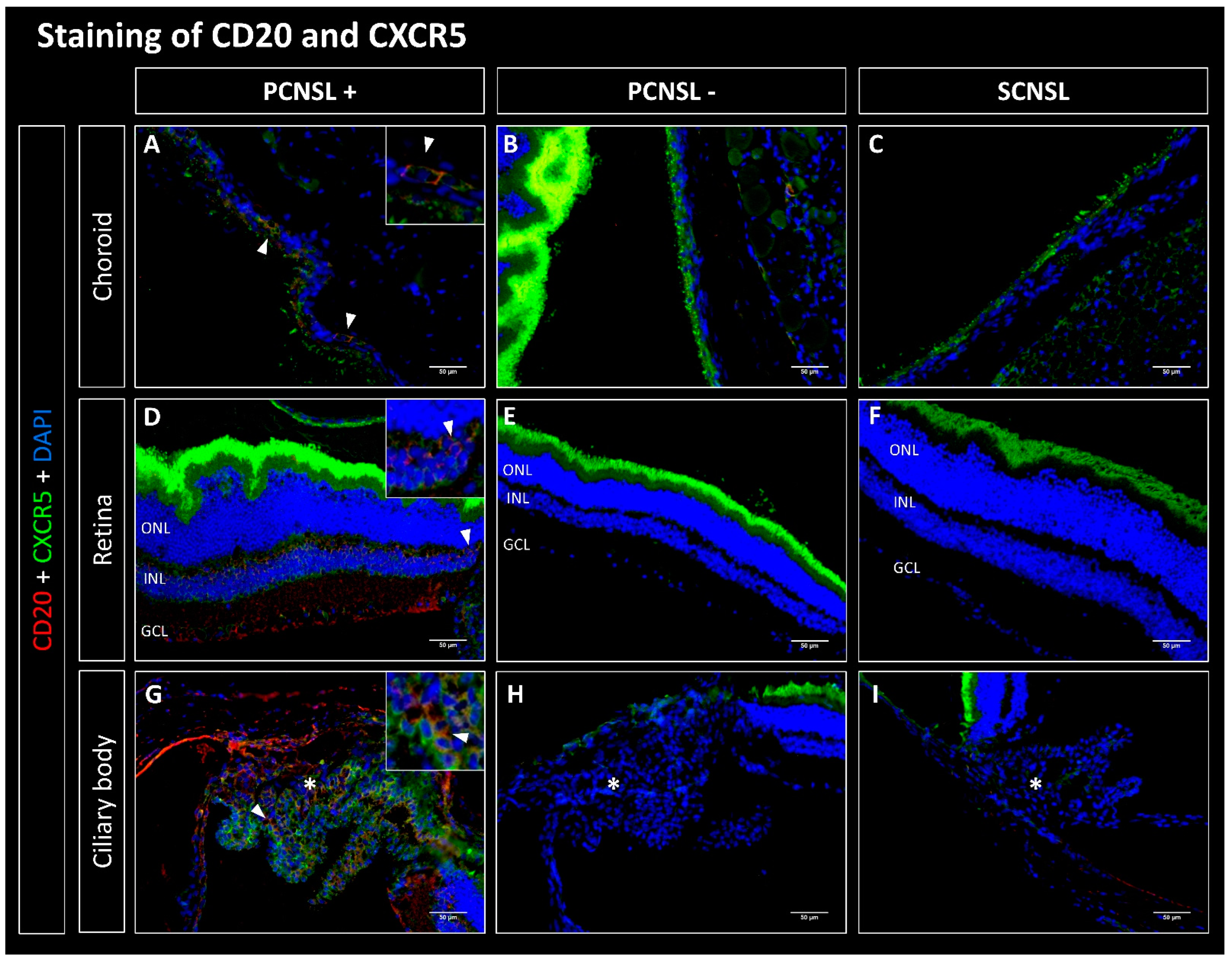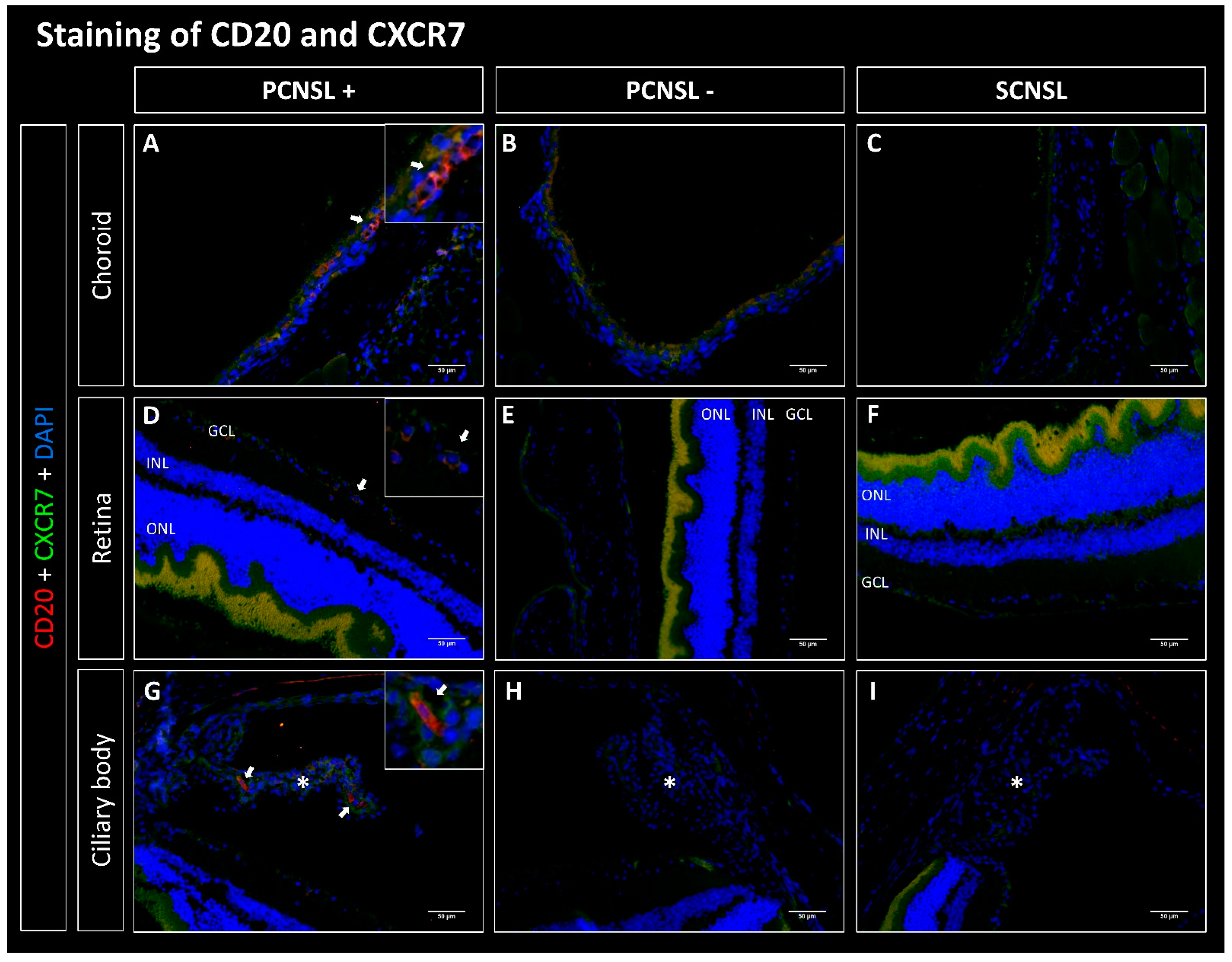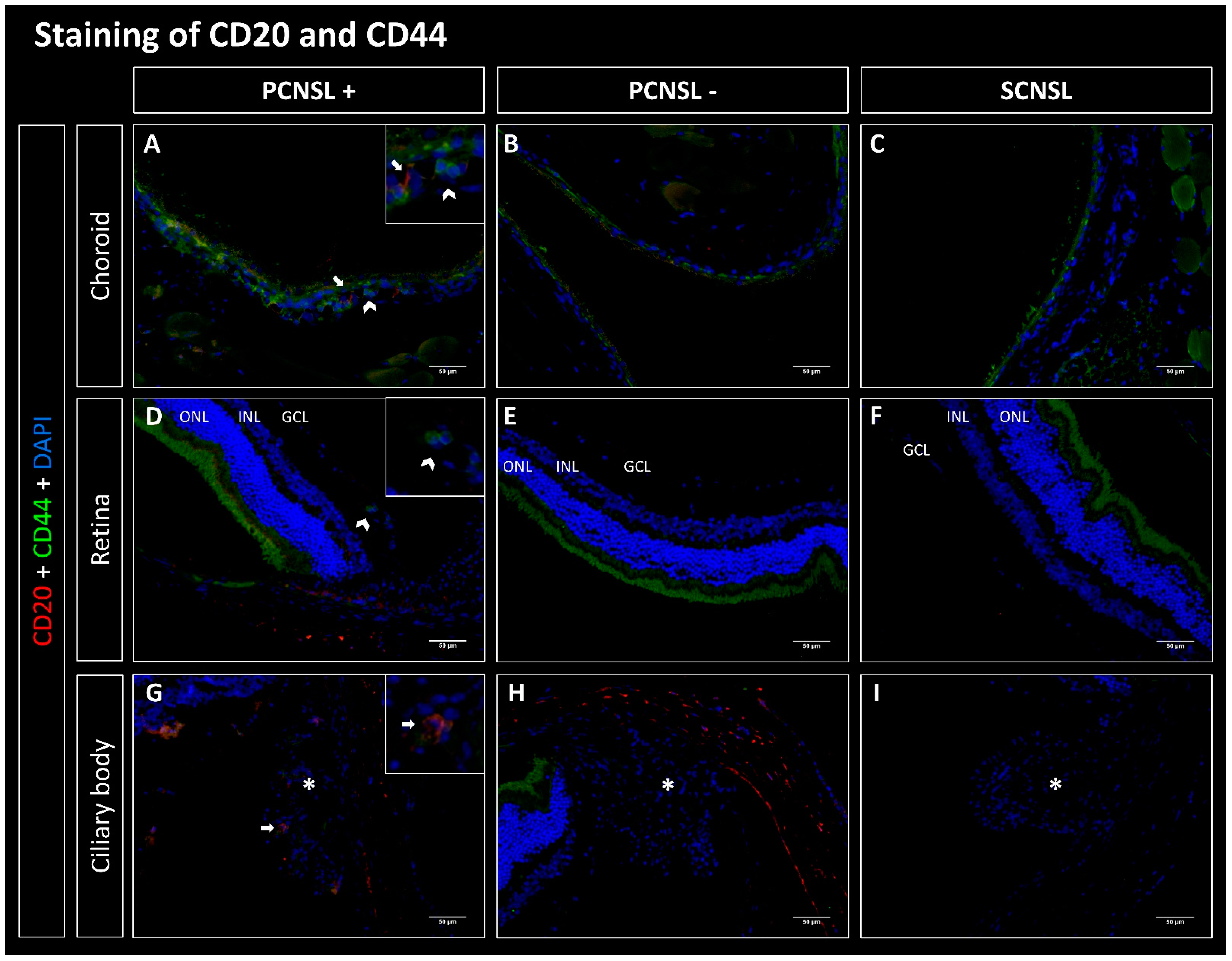CXCR4, CXCR5 and CD44 May Be Involved in Homing of Lymphoma Cells into the Eye in a Patient Derived Xenograft Homing Mouse Model for Primary Vitreoretinal Lymphoma
Abstract
1. Introduction
2. Results
2.1. CD20-Positive Lymphoma Cells Are Mostly Found in the Choroid in the PCNSL Group
2.2. CD20-Positive Lymphoma Cells Co-Express CXCR4, CXCR5 and CD44 but Not CXCR7
2.3. The CXCR5 Receptor Was Most Frequently Co-Expressed among All Examined Homing-Receptors
2.3.1. Choroid
2.3.2. Retina
2.3.3. Ciliary Body
2.4. CD20, CXCR4, CXCR5 and CD44 Are Expressed Significantly Higher in the PCNSL-Group Compared to the SCNSL-Group
2.4.1. Choroid
2.4.2. Retina
2.4.3. Ciliary Body
3. Discussion
3.1. CD20+ Cell Infiltration
3.2. Co-Expression of CD20 and Homing Receptors
3.2.1. CD20/CXCR4 Co-Expression
3.2.2. CD20/CXCR5 Co-Expression
3.2.3. CD20/CXCR7 Co-Expression
3.2.4. CD20/CD44 Co-Expression
3.3. Limitations
4. Materials and Methods
4.1. PDX Mouse Model
4.2. Primary and Secondary Antibodies
4.3. Double Indirect Immunofluorescence Staining
4.4. Cell Counting
4.5. Evaluation with the IRS
4.6. Statistical Analysis
5. Conclusions
Supplementary Materials
Author Contributions
Funding
Institutional Review Board Statement
Informed Consent Statement
Data Availability Statement
Acknowledgments
Conflicts of Interest
References
- Chan, C.-C.; Rubenstein, J.L.; Coupland, S.E.; Davis, J.L.; Harbour, J.W.; Johnston, P.B.; Cassoux, N.; Touitou, V.; Smith, J.R.; Batchelor, T.T.; et al. Primary vitreoretinal lymphoma: A report from an international primary central nervous system lymphoma collaborative group symposium. Oncologist 2011, 16, 1589–1599. [Google Scholar] [CrossRef] [PubMed]
- Venkatesh, R.; Bavaharan, B.; Mahendradas, P.; Yadav, N.K. Primary vitreoretinal lymphoma: Prevalence, impact, and management challenges. Clin. Ophthalmol. 2019, 13, 353–364. [Google Scholar] [CrossRef] [PubMed]
- Sobolewska, B.; Chee, S.-P.; Zaguia, F.; Goldstein, D.; Smith, J.; Fend, F.; Mochizuki, M.; Zierhut, M. Vitreoretinal Lymphoma. Cancers 2021, 13, 3921. [Google Scholar] [CrossRef] [PubMed]
- Fend, F.; Ferreri, A.J.M.; Coupland, S. How we diagnose and treat vitreoretinal lymphoma. Br. J. Haematol. 2016, 173, 680–692. [Google Scholar] [CrossRef] [PubMed]
- Steffen, J.; Coupland, S.E.; Smith, J.R. Primary vitreoretinal lymphoma in HIV infection. Ocul. Immunol. Inflamm. 2021, 29, 621–627. [Google Scholar] [CrossRef]
- Araujo, I.; Coupland, S.E. Primary vitreoretinal lymphoma—A review. Asia-Pacific J. Ophthalmol. 2017, 6, 283–289. [Google Scholar] [CrossRef]
- Sagoo, M.S.; Mehta, H.; Swampillai, A.J.; Cohen, V.; Amin, S.Z.; Plowman, P.N.; Lightman, S. Primary intraocular lymphoma. Surv. Ophthalmol. 2014, 59, 503–516. [Google Scholar] [CrossRef]
- Coupland, S.E.; Heimann, H.; Bechrakis, N.E. Primary intraocular lymphoma: A review of the clinical, histopathological and molecular biological features. Graefe’s Arch. Clin. Exp. Ophthalmol. 2004, 242, 901–913. [Google Scholar] [CrossRef]
- Coupland, S.E.; Damato, B. Understanding intraocular lymphomas. Clin. Exp. Ophthalmol. 2008, 36, 564–578. [Google Scholar] [CrossRef]
- Wright, D. Pathology of extra-nodal non Hodgkin lymphomas. Clin. Oncol. 2012, 24, 319–328. [Google Scholar] [CrossRef]
- Aho, R.; Ekfors, T.; Haltia, M.; Kalimo, H. Pathogenesis of primary central nervous system lymphoma: Invasion of malignant lymphoid cells into and within the brain parenchyme. Acta Neuropathol. 1993, 86, 71–76. [Google Scholar] [CrossRef] [PubMed]
- Li, J.; Okamoto, H.; Yin, C.; Jagannathan, J.; Takizawa, J.; Aoki, S.; Gläsker, S.; Rushing, E.J.; Vortmeyer, A.O.; Oldfield, E.H.; et al. Proteomic characterization of primary diffuse large B-cell lymphomas in the central nervous system. J. Neurosurg. 2008, 109, 536–546. [Google Scholar] [CrossRef] [PubMed]
- King, R.L.; Goodlad, J.R.; Calaminici, M.; Dotlic, S.; Montes-Moreno, S.; Oschlies, I.; Ponzoni, M.; Traverse-Glehen, A.; Ott, G.; Ferry, J.A. Lymphomas arising in immune-privileged sites: Insights into biology, diagnosis, and pathogenesis. Virchows Arch. 2020, 476, 647–665. [Google Scholar] [CrossRef] [PubMed]
- Hochberg, F.H.; Miller, D.C. Primary central nervous system lymphoma. J. Neurosurg. 1988, 68, 835–853. [Google Scholar] [CrossRef] [PubMed]
- Nakamura, M.; Shimada, K.; Ishida, E.; Konishi, N. Histopathology, pathogenesis and molecular genetics in primary central nervous system lymphomas. Histol. Histopathol. 2004, 19, 211–219. [Google Scholar] [CrossRef] [PubMed]
- Pasqualucci, L.; Dalla-Favera, R. Genetics of diffuse large B-cell lymphoma. Blood 2018, 131, 2307–2319. [Google Scholar] [CrossRef]
- Hochman, J.; Assaf, N.; Deckert-Schlüter, M.; Wiestler, O.D.; Pe’Er, J. Entry routes of malignant lymphoma into the brain and eyes in a mouse model. Cancer Res. 2001, 61, 5242–5247. [Google Scholar]
- Burger, J.A.; Kipps, T.J. Chemokine receptors and stromal cells in the homing and homeostasis of chronic lymphocytic leukemia B cells. Leuk. Lymphoma 2002, 43, 461–466. [Google Scholar] [CrossRef]
- Hochman, J.; Shen, D.; Gottesman, M.M.; Chan, C.-C. Anti-LFA-1 antibodies enhance metastasis of ocular lymphoma to the brain and contralateral eye. Clin. Exp. Metastasis 2013, 30, 91–102. [Google Scholar] [CrossRef]
- Butcher, E.C.; Picker, L.J. Lymphocyte homing and homeostasis. Science 1996, 272, 60–67. [Google Scholar] [CrossRef]
- Man, S.; Ubogu, E.E.; Ransohoff, R.M. Inflammatory cell migration into the central nervous system: A few new twists on an old tale. Brain Pathol. 2007, 17, 243–250. [Google Scholar] [CrossRef] [PubMed]
- Bhutto, I.A.; McLeod, D.S.; Merges, C.; Hasegawa, T.; Lutty, G.A. Localisation of SDF-1 and its receptor CXCR4 in retina and choroid of aged human eyes and in eyes with age related macular degeneration. Br. J. Ophthalmol. 2006, 90, 906–910. [Google Scholar] [CrossRef] [PubMed][Green Version]
- Ratajczak, M.Z.; Zuba-Surma, E.; Kucia, M.; Reca, R.; Wojakowski, W.; Ratajczak, J. The pleiotropic effects of the SDF-1–CXCR4 axis in organogenesis, regeneration and tumorigenesis. Leukemia 2006, 20, 1915–1924. [Google Scholar] [CrossRef]
- Teicher, B.A.; Fricker, S.P. CXCL12 (SDF-1)/CXCR4 pathway in cancer. Clin. Cancer Res. 2010, 16, 2927–2931. [Google Scholar] [CrossRef] [PubMed]
- Hughes, C.E.; Nibbs, R.J.B. A guide to chemokines and their receptors. FEBS J. 2018, 285, 2944–2971. [Google Scholar] [CrossRef] [PubMed]
- Janssens, R.; Struyf, S.; Proost, P. The unique structural and functional features of CXCL12. Cell. Mol. Immunol. 2018, 15, 299–311. [Google Scholar] [CrossRef] [PubMed]
- Naumann, U.; Cameroni, E.; Pruenster, M.; Mahabaleshwar, H.; Raz, E.; Zerwes, H.-G.; Rot, A.; Thelen, M. CXCR7 functions as a scavenger for CXCL12 and CXCL11. PLoS ONE 2010, 5, e9175. [Google Scholar] [CrossRef]
- Förster, R.; Mattis, A.E.; Kremmer, E.; Wolf, E.; Brem, G.; Lipp, M. A Putative chemokine receptor, BLR1, directs B cell migration to defined lymphoid organs and specific anatomic compartments of the spleen. Cell 1996, 87, 1037–1047. [Google Scholar] [CrossRef]
- Smith, J.; Braziel, R.M.; Paoletti, S.; Lipp, M.; Uguccioni, M.; Rosenbaum, J.T. Expression of B-cell–attracting chemokine 1 (CXCL13) by malignant lymphocytes and vascular endothelium in primary central nervous system lymphoma. Blood 2003, 101, 815–821. [Google Scholar] [CrossRef]
- Hussain, M.; Adah, D.; Tariq, M.; Lu, Y.; Zhang, J.; Liu, J.; Hussain, M.; Adah, D.; Tariq, M.; Lu, Y.; et al. CXCL13/CXCR5 signaling axis in cancer. Life Sci. 2019, 227, 175–186. [Google Scholar] [CrossRef]
- Stamenkovic, I.; Amiot, M.; Pesando, J.M.; Seed, B. A lymphocyte molecule implicated in lymph node homing is a member of the cartilage link protein family. Cell 1989, 56, 1057–1062. [Google Scholar] [CrossRef]
- Nishina, S.; Hirakata, A.; Hida, T.; Sawa, H.; Azuma, N. CD44 expression in the developing human retina. Graefe’s Arch. Clin. Exp. Ophthalmol. 1997, 235, 92–96. [Google Scholar] [CrossRef]
- Heldin, P.; Kolliopoulos, C.; Lin, C.-Y.; Heldin, C.-H. Involvement of hyaluronan and CD44 in cancer and viral infections. Cell. Signal. 2020, 65, 109427. [Google Scholar] [CrossRef] [PubMed]
- Itano, N.; Kimata, K. Mammalian hyaluronan synthases. IUBMB Life 2002, 54, 195–199. [Google Scholar] [CrossRef] [PubMed]
- Jordan, A.R.; Racine, R.R.; Hennig, M.J.P.; Lokeshwar, V.B. The role of CD44 in disease pathophysiology and targeted treatment. Front. Immunol. 2015, 6, 182. [Google Scholar] [CrossRef] [PubMed]
- Isbell, L.K.; Tschuch, C.; Doostkam, S.; Reinacher, P.C.; Shoumariyeh, K.; Waldeck, S.; Bartsch, I.; Schorb, E.; Scherer, F.; Pantic, M.; et al. Patient-Derived Xenograft Mouse Model to Investigate Tropism to the Central Nervous System and Retina in Primary and Secondary Central Nervous System Lymphoma; Department of Medicine I, Medical Center—University of Freiburg: Freiburg, Germany, 2022; (manuscript in revision to be re-submitted to Neuropathology and Applied Neurobiology). [Google Scholar]
- Touitou, V.; Daussy, C.; Bodaghi, B.; Camelo, S.; De Kozak, Y.; LeHoang, P.; Naud, M.-C.; Varin, A.; Thillaye-Goldenberg, B.; Merle-Béral, H.; et al. Impaired Th1/Tc1 cytokine production of tumor-infiltrating lymphocytes in a model of primary Intraocular B-cell lymphoma. Investig. Opthalmol. Vis. Sci. 2007, 48, 3223–3229. [Google Scholar] [CrossRef]
- Ben Abdelwahed, R.; Donnou, S.; Ouakrim, H.; Crozet, L.; Cosette, J.; Jacquet, A.; Tourais, I.; Fournès, B.; Bocquet, M.G.; Miloudi, A.; et al. Preclinical study of ublituximab, a glycoengineered anti-human CD20 antibody, in murine models of primary cerebral and intraocular B-cell lymphomas. Investig. Opthalmol. Vis. Sci. 2013, 54, 3657–3665. [Google Scholar] [CrossRef]
- Li, Z.; Mahesh, S.P.; Shen, D.F.; Liu, B.; Siu, W.O.; Hwang, F.S.; Wang, Q.-C.; Chan, C.-C.; Pastan, I.; Nussenblatt, R.B. Eradication of tumor colonization and invasion by a b cell–specific immunotoxin in a murine model for human primary intraocular lymphoma. Cancer Res. 2006, 66, 10586–10593. [Google Scholar] [CrossRef]
- Mineo, J.-F.; Scheffer, A.; Karkoutly, C.; Nouvel, L.; Kerdraon, O.; Trauet, J.; Bordron, A.; Dessaint, J.-P.; Labalette, M.; Berthou, C.; et al. Using human CD20-transfected murine lymphomatous B cells to evaluate the efficacy of intravitreal and intracerebral rituximab injections in mice. Investig. Opthalmol. Vis. Sci. 2008, 49, 4738–4745. [Google Scholar] [CrossRef]
- Chan, C.-C.; Shen, D.; Hackett, J.J.; Buggage, R.R.; Tuaillon, N. Expression of chemokine receptors, CXCR4 and CXCR5, and chemokines, BLC and SDF-1, in the eyes of patients with primary intraocular lymphoma. Ophthalmology 2003, 110, 421–426. [Google Scholar] [CrossRef]
- Chan, C. Molecular pathology of primary intraocular lymphoma. Am. J. Ophthalmol. 2004, 137, 975. [Google Scholar] [CrossRef][Green Version]
- Lemma, S.A.; Pasanen, A.K.; Haapasaari, K.-M.; Sippola, A.; Sormunen, R.; Soini, Y.; Jantunen, E.; Koivunen, P.; Salokorpi, N.; Bloigu, R.; et al. Similar chemokine receptor profiles in lymphomas with central nervous system involvement—Possible biomarkers for patient selection for central nervous system prophylaxis, a retrospective study. Eur. J. Haematol. 2015, 96, 492–501. [Google Scholar] [CrossRef] [PubMed]
- Brunn, A.; Montesinos-Rongen, M.; Strack, A.; Reifenberger, G.; Mawrin, C.; Schaller, C.; Deckert, M. Expression pattern and cellular sources of chemokines in primary central nervous system lymphoma. Acta Neuropathol. 2007, 114, 271–276. [Google Scholar] [CrossRef]
- Smith, J.R.; Falkenhagen, K.M.; Coupland, S.E.; Chipps, T.J.; Rosenbaum, J.T.; Braziel, R.M. Malignant B cells from patients with primary central nervous system lymphoma express stromal cell–derived factor-1. Am. J. Clin. Pathol. 2007, 127, 633–641. [Google Scholar] [CrossRef]
- Menter, T.; Ernst, M.; Drachneris, J.; Dirnhofer, S.; Barghorn, A.; Went, P.; Tzankov, A. Phenotype profiling of primary testicular diffuse large B-cell lymphomas: Phenotype Profiling of TDLBCL. Hematol. Oncol. 2013, 32, 72–81. [Google Scholar] [CrossRef] [PubMed]
- Ollikainen, R.K.; Kotkaranta, P.H.; Kemppainen, J.; Teppo, H.-R.; Kuitunen, H.; Pirinen, R.; Turpeenniemi-Hujanen, T.; Kuittinen, O.; Kuusisto, M.E. Different chemokine profile between systemic and testicular diffuse large B-cell lymphoma. Leuk. Lymphoma 2021, 62, 2151–2160. [Google Scholar] [CrossRef]
- Cheah, C.Y.; Wirth, A.; Seymour, J.F. Primary testicular lymphoma. Blood 2014, 123, 486–493. [Google Scholar] [CrossRef]
- Puddinu, V.; Casella, S.; Radice, E.; Thelen, S.; Dirnhofer, S.; Bertoni, F.; Thelen, M. ACKR3 expression on diffuse large B cell lymphoma is required for tumor spreading and tissue infiltration. Oncotarget 2017, 8, 85068–85084. [Google Scholar] [CrossRef][Green Version]
- Moreno, M.J.; Gallardo, A.; Novelli, S.; Mozos, A.; Aragó, M.; Pavon, M.A.; Céspedes, M.V.; Pallarès, V.; Falgàs, A.; Alcoceba, M.; et al. CXCR7 expression in diffuse large B-cell lymphoma identifies a subgroup of CXCR4+ patients with good prognosis. PLoS ONE 2018, 13, e0198789. [Google Scholar] [CrossRef]
- Aho, R.; Jalkanen, S.; Kalimo, H. CD44-hyaluronate interaction mediates in vitro lymphocyte binding to the white matter of the central nervous system. J. Neuropathol. Exp. Neurol. 1994, 53, 295–302. [Google Scholar] [CrossRef]
- Yuan, J.; Gu, K.; He, J.; Sharma, S. Preferential up-regulation of osteopontin in primary central nervous system lymphoma does not correlate with putative receptor CD44v6 or CD44H expression. Hum. Pathol. 2013, 44, 606–611. [Google Scholar] [CrossRef] [PubMed]
- Lemma, S.A.; Kuusisto, M.; Haapasaari, K.-M.; Sormunen, R.; Lehtinen, T.; Klaavuniemi, T.; Eray, M.; Jantunen, E.; Soini, Y.; Vasala, K.; et al. Integrin alpha 10, CD44, PTEN, cadherin-11 and lactoferrin expressions are potential biomarkers for selecting patients in need of central nervous system prophylaxis in diffuse large B-cell lymphoma. Carcinogenesis 2017, 38, 812–820. [Google Scholar] [CrossRef] [PubMed]
- Horstmann, W.; Timens, W. Lack of adhesion molecules in testicular diffuse centroblastic and immunoblastic B cell lymphomas as a contributory factor in malignant behaviour. Virchows Arch. 1996, 429, 83–90. [Google Scholar] [CrossRef]
- Hasselblom, S.; Ridell, B.; Wedel, H.; Norrby, K.; Baum, M.S.; Ekman, T. Testicular lymphoma a retrospective, population-based, clinical and immunohistochemical study. Acta Oncol. 2004, 43, 758–765. [Google Scholar] [CrossRef]
- He, M.; Zuo, C.; Wang, J.; Liu, J.; Jiao, B.; Zheng, J.; Cai, Z. Prognostic significance of the aggregative perivascular growth pattern of tumor cells in primary central nervous system diffuse large B-cell lymphoma. Neuro-Oncology 2013, 15, 727–734. [Google Scholar] [CrossRef] [PubMed]
- Naor, D.; Nedvetzki, S.; Golan, I.; Melnik, L.; Faitelson, Y. CD44 in cancer. Crit. Rev. Clin. Lab. Sci. 2002, 39, 527–579. [Google Scholar] [CrossRef]
- Bignami, A.; Hosley, M.; Dahl, D. Hyaluronic acid and hyaluronic acid-binding proteins in brain extracellular matrix. Anat. Embryol. 1993, 188, 419–433. [Google Scholar] [CrossRef] [PubMed]
- Avigdor, A.; Goichberg, P.; Shivtiel, S.; Dar, A.; Peled, A.; Samira, S.; Kollet, O.; Hershkoviz, R.; Alon, R.; Hardan, I.; et al. CD44 and hyaluronic acid cooperate with SDF-1 in the trafficking of human CD34+ stem/progenitor cells to bone marrow. Blood 2004, 103, 2981–2989. [Google Scholar] [CrossRef]
- Mishima, H.; Hasebe, H. Some observations in the fine structure of age changes of the mouse retinal pigment epithelium. Albrecht Von Graefes Arch. Klin. Exp. Ophthalmol. 1978, 209, 1–9. [Google Scholar] [CrossRef]
- Zhou, X.; Mulazzani, M.; Von Mücke-Heim, I.-A.; Langer, S.; Zhang, W.; Ishikawa-Ankerhold, H.; Dreyling, M.; Straube, A.; Von Baumgarten, L. The role of BAFF-R signaling in the growth of primary central nervous system lymphoma. Front. Oncol. 2020, 10, 682. [Google Scholar] [CrossRef]
- Desai, V.D.; Wang, Y.; Simirskii, V.; Duncan, M.K. CD44 expression is developmentally regulated in the mouse lens and increases in the lens epithelium after injury. Differentiation 2010, 79, 111–119. [Google Scholar] [CrossRef] [PubMed][Green Version]
- Saha, A.; Ahn, S.; Blando, J.; Su, F.; Kolonin, M.G.; DiGiovanni, J. Proinflammatory CXCL12–CXCR4/CXCR7 signaling axis drives MYC-induced prostate cancer in obese mice. Cancer Res. 2017, 77, 5158–5168. [Google Scholar] [CrossRef] [PubMed]
- Liu, Y.; Yang, Z.; Lai, P.; Huang, Z.; Sun, X.; Zhou, T.; He, C.; Liu, X. Bcl-6-directed follicular helper T cells promote vascular inflammatory injury in diabetic retinopathy. Theranostics 2020, 10, 4250–4264. [Google Scholar] [CrossRef] [PubMed]
- Shen, J.; Luo, X.; Wu, Q.; Huang, J.; Xiao, G.; Wang, L.; Yang, B.; Li, H.; Wu, C. A subset of CXCR5+CD8+ T cells in the germinal centers from human tonsils and lymph nodes help B cells produce immunoglobulins. Front. Immunol. 2018, 9, 2287. [Google Scholar] [CrossRef] [PubMed]
- Xiao, L.; Jia, L.; Zhang, Y.; Yu, S.; Wu, X.; Yang, B.; Li, H.; Wu, C. Human IL-21+IFN-γ+CD4+ T cells in nasal polyps are regulated by IL-12. Sci. Rep. 2015, 5, 12781. [Google Scholar] [CrossRef] [PubMed]
- Cao, X.; Li, W.; Liu, Y.; Huang, H.; Ye, C.-H. The Anti-inflammatory effects of CXCR5 in the mice retina following ischemia-reperfusion injury. BioMed Res. Int. 2019, 2019, 3487607. [Google Scholar] [CrossRef]
- Schindelin, J.; Arganda-Carreras, I.; Frise, E.; Kaynig, V.; Longair, M.; Pietzsch, T.; Preibisch, S.; Rueden, C.; Saalfeld, S.; Schmid, B.; et al. Fiji: An open-source platform for biological-image analysis. Nat. Methods 2012, 9, 676–682. [Google Scholar] [CrossRef]
- Remmele, W.; Stegner, H.E. Recommendation for uniform definition of an immunoreactive score (IRS) for immunohistochemical estrogen receptor detection (ER-ICA) in breast cancer tissue. Pathologe 1987, 8, 138–140. [Google Scholar]
- Van Ipenburg, J.A.; De Waard, N.E.; Naus, N.C.; Jager, M.J.; Paridaens, D.; Verdijk, R.M. Chemokine receptor expression pattern correlates to progression of conjunctival melanocytic lesions. Investig. Ophthalmol. Vis. Sci. 2019, 60, 2950–2957. [Google Scholar] [CrossRef]





Publisher’s Note: MDPI stays neutral with regard to jurisdictional claims in published maps and institutional affiliations. |
© 2022 by the authors. Licensee MDPI, Basel, Switzerland. This article is an open access article distributed under the terms and conditions of the Creative Commons Attribution (CC BY) license (https://creativecommons.org/licenses/by/4.0/).
Share and Cite
Babst, N.; Isbell, L.K.; Rommel, F.; Tura, A.; Ranjbar, M.; Grisanti, S.; Tschuch, C.; Schueler, J.; Doostkam, S.; Reinacher, P.C.; et al. CXCR4, CXCR5 and CD44 May Be Involved in Homing of Lymphoma Cells into the Eye in a Patient Derived Xenograft Homing Mouse Model for Primary Vitreoretinal Lymphoma. Int. J. Mol. Sci. 2022, 23, 11757. https://doi.org/10.3390/ijms231911757
Babst N, Isbell LK, Rommel F, Tura A, Ranjbar M, Grisanti S, Tschuch C, Schueler J, Doostkam S, Reinacher PC, et al. CXCR4, CXCR5 and CD44 May Be Involved in Homing of Lymphoma Cells into the Eye in a Patient Derived Xenograft Homing Mouse Model for Primary Vitreoretinal Lymphoma. International Journal of Molecular Sciences. 2022; 23(19):11757. https://doi.org/10.3390/ijms231911757
Chicago/Turabian StyleBabst, Neele, Lisa K. Isbell, Felix Rommel, Aysegul Tura, Mahdy Ranjbar, Salvatore Grisanti, Cordula Tschuch, Julia Schueler, Soroush Doostkam, Peter C. Reinacher, and et al. 2022. "CXCR4, CXCR5 and CD44 May Be Involved in Homing of Lymphoma Cells into the Eye in a Patient Derived Xenograft Homing Mouse Model for Primary Vitreoretinal Lymphoma" International Journal of Molecular Sciences 23, no. 19: 11757. https://doi.org/10.3390/ijms231911757
APA StyleBabst, N., Isbell, L. K., Rommel, F., Tura, A., Ranjbar, M., Grisanti, S., Tschuch, C., Schueler, J., Doostkam, S., Reinacher, P. C., Duyster, J., Kakkassery, V., & von Bubnoff, N. (2022). CXCR4, CXCR5 and CD44 May Be Involved in Homing of Lymphoma Cells into the Eye in a Patient Derived Xenograft Homing Mouse Model for Primary Vitreoretinal Lymphoma. International Journal of Molecular Sciences, 23(19), 11757. https://doi.org/10.3390/ijms231911757






